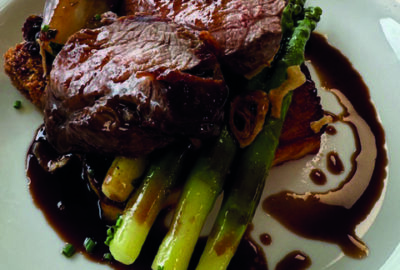With the Baby Boomer generation set to be the next ‘intake’ of care home residents, it might be time for a menu shake-up. Whilst most current care home residents have favoured traditional fayre, those born between 1946 and 1964 have enjoyed more travel abroad and exposure to international cuisines. But how can care caterers adapt these global cuisines to suit their menus and the dietary conditions facing their residents? Here’ several industry experts share their thoughts and ideas…
BARRY DART kitchen manager, Park Lane Nursing Home, Barnstable,Devon
Our residents definitely prefer food which has strong flavours, such as curries and anything spicy. Whilst previously, residents wanted plain boiled rice, now they want egg fried rice with chilli in it. Even things like chicken goujons are served with Country Range Sweet Chilli Dipping Sauce to give them a kick. Our most popular dish is spicy meatballs with spaghetti. We make them with minced beef, garlic, fresh chilli and herbs bound together with egg and served with spaghetti in Country Range Ready to Use Tomato and Basil Sauce. A lot of our residents need foods which are fortified so we’ll make Thai curry with full fat coconut milk and also double or whipping cream. Strong flavours are really important for people living with dementia and they always remember and comment on the spicy dishes we’ve made – but never things like cottage pie.
SARAH LESSER-MOOR brand manager for Lion sauces at AAK Foodservice Lion World Flavours sauces are designed for those who love bringing the flavours of global cuisines to their food. Our latest collection of dressings can instantly transform a dish with minimal effort. Give king prawns and noodles a vivid burst of Asian flavour with chilli, lime and lemongrass dressing, or evoke Mediterranean memories with pan-fried seabass dressed with the fresh, uplifting flavour of basil oil. If you’re looking for salad inspiration, try cider, honey and mustard dressing – it’s a product that really earns its keep in the kitchen, as it also goes beautifully with mash, chicken or sausages!
PRESTON WALKER director of Oakhouse Residential Home in Rutland
One way of helping people with dementia to eat more is to offer foods that evoke deep-routed memories of pleasure brought back through smells, tastes and sounds. Serving finger foods can also help however can be tricky with classic care home dishes. For well travelled people who enjoy foods from all over the world evoking wonderful memories through finger food may become easier. The flavours of distant countries are defined by the wonderful spices and herbs that grow locally – and these can easily be incorporated into street food style bites. We can find examples of foods designed to be eaten with fingers everywhere we look: Indian Pakora, Chinese Dumplings, Japanese Maki Rolls and Jamaican Fritters. For a simple Mexican Quesadilla just take a base of chilli beef, rice and cheese placed between a folded tortilla and fry until crisp on both sides. Once cooled and cut into pieces this makes a delicious and authentic dish easily picked up and eaten. They’re quick and easy to make, taste great and can bring back great memories of travelling abroad.
JAMES BALL development chef and director of Oak House Kitchen
Current dysphagia meals stick closely to the ‘meat and two veg’ dishes found on classic care menus and mashed potatoes complement the flavours on the plate. As tastes change we are going to see far more dishes that reflect travel and accessibility of ingredients. Mashed potato is going to look a little out of place sitting next to ‘sweet and sour pork’ and ‘Thai green curry’ or found layered in a texture modified lasagne. Oak House Kitchen has developed techniques that make delicious versions of starchy side dishes from around the world that fit the IDDSI Framework, making it easy for you to serve noodles, naan and nachos when they‘re needed! Spaghetti pasta is easily made by blending cooked pasta, fragrant stock, cauliflower and Parmesan to the correct consistency. The spaghetti effect is achieved using a piping bag with a small hole cut at the tip and can be served with a rich beef ragu to create Spaghetti Bolognaise. For more details: www.oakhouse-kitchen.com
OLIVER SMITH freelance consultant chef and NACC Care Cook of the Year 2015
It’s vital in any care establishment to talk to your residents, find out who they are and what they like, then create menus around their likes and dislikes. Putting out generic menus never works, residents want to be involved in the menu creation, it’s a big part of each day, awaiting a delicious meal that invokes memories and good times. It’s also important to put in a few ideas of your own, some more modern dishes as well as classics as it will surprise residents and make them try new things. I predict that mash potato and steamed veg won’t be enough to please future residents, time to try new things! Some dishes we’ve had on our menus are beetroot gnocchi, feta and toasted walnuts, hoisin duck wraps and fragrant Thai green curries.
SUE CAWTHRAY national chair, National Association of Care Catering (NACC)
I’ve spoken to a number of Baby Boomers and the clear message is that menus must offer choice. Traditional British fayre remains popular, but the presentation and flavours have evolved – think ‘posh fish and chips’ and the vast flavour varieties of pies. This generation has enjoyed more international cuisines both in travel and locally, so menus should reflect this. Changes in lifestyle choices will also have an impact. Baby Boomers are more conscious of their health and there’s been a shift to eating less red meat and more vegetables, for example, and of course a rise in vegetarianism and veganism. The option to eat what they want and when is also an expectation. As working days and lifestyles have become more flexible, structured routines are no longer the norm.
NICK DUTTON operations manager, Primrose Bank Residential Care Home, Poulton-le-Fylde
Care catering is certainly changing. Those in care have a much broader range of tastes and preference as well as dietary requirements to cater for. We are seeing huge resident uptake in our themed food days, wine and cheese nights and dinner clubs. Personally, I think the key to meeting the catering expectations in the home is for managers to give their chefs time in their schedule to get out of the kitchen and talk to their residents. The knowledge of food and cooking that some of our residents have is expansive and enlightening.
JOEL CARR development chef at Young’s Foodservice
The lean and tender texture of Alaska Pollock and Pink Salmon has excellent flaking qualities which can also be beneficial for residents with swallowing difficulties. Vibrant and fresh Asian flavours particularly suit the adventurous boomers’ craving for international cuisine and are easy to replicate on care home menus. For a deliciously simple South East Asian inspired dish, combine Alaska Pollock and Pink Salmon pieces with a selection of sautéed vegetables you have to hand, noodles and vegetable broth combined with soy sauce, fish sauce or miso paste for a warming bowl of goodness packed full of authentic flavour and nutritional value. Young’s MSC certified Pink Salmon & Alaska Pollock Pieces are an ideal and convenient solution for caterers because it can be added to recipes straight from frozen while also being high in Omega 3.
KEVIN PRICE chef manager, Oulton Abbey Care Home, Stone, Staffordshire, and winner of the Bisto Care Caterer of the Year 2019
In recent years the care home menu has moved towards a mixture of traditional British fayre and choices from the international reaches of the globe. At Oulton Abbey we are finding that the tastes and pallets of our residents has an interesting and diverse spectrum. Some examples of the dishes on our menu are Moroccan tagine, New England chowder, Nasi Goreng (Indonesian Stir Fried Rice), Aloo Gobi with Jeera Rice, lamb and spinach paneer, saltfish and Ackee to name just a few. As we move into a new decade it is so important that we continue to mix up our menus and consider the variety of taste, flavours and life experiences of our ever-changing customer base. I find that, in recent years, residents are looking for dishes that offer some level of spice and heat and, after taking time to talk with them, most are familiar with curries, rice and bread from the Indian regions. I include one curry a week on our menu across the home as it also lends itself well to fortification and texture modification.


